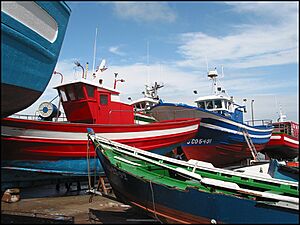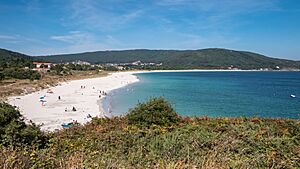Fisterra facts for kids
Quick facts for kids
Fisterra
|
||
|---|---|---|
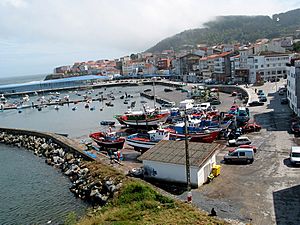 |
||
|
||
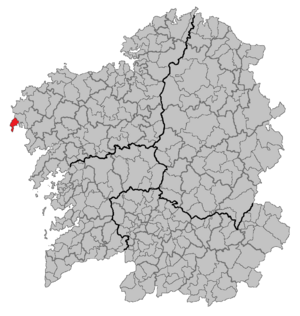 |
||
| Country | ||
| Autonomous community | ||
| Province | A Coruña | |
| Comarca | Fisterra | |
| Area | ||
| • Total | 29.43 km2 (11.36 sq mi) | |
| Population
(2018)
|
||
| • Total | 4,701 | |
| • Density | 159.73/km2 (413.71/sq mi) | |
| Demonym(s) | fisterrán, -á | |
| Time zone | UTC+1 (CET) | |
| • Summer (DST) | UTC+2 (CEST) | |
| Postal code |
15155
|
|
| Dialing code | 981 | |
Fisterra, also known as Finisterre, is a town in Spain. It is located in Galicia, a region in the northwest of Spain. Fisterra sits on Cape Finisterre, which is a famous spot for pilgrims. These pilgrims walk the "Way of St. James" and often continue their journey here after visiting Santiago de Compostela.
Fisterra is part of the rocky Costa da Morte (which means "Coast of Death" in Galician). This name comes from the many shipwrecks that happened here. The name Fisterra itself means "Land's End" in Latin. This is because it is on a peninsula that feels like the very edge of the land in Spain.
Fisterra is an old port and fishing village. It has narrow streets that lead to a main square called Plaza de Ara Solis. You can find the Nosa Señora do Bon Suceso chapel here, which was built in the 1700s. There is also a lighthouse on a 600-meter high point called "Monte Facho" at the tip of Cape Finisterre. It looks out over the Atlantic Ocean. On the way to the lighthouse, you will see the Santa María de Fisterra church. It has a special area called the Chapel of Santo Cristo.
Fisterra is about 108 kilometers from A Coruña and 98 kilometers from Santiago de Compostela.
Contents
Exploring Fisterra's Geography
Fisterra has many beautiful beaches. Some of them include O Rostro, Arnela, Mar de Fóra, Langosteira, Ribeira, and Corveiro.
The area also has several interesting rocks. These rocks are linked to old legends and stories. Some are known as the "holy stones" or the "stained wine stones." There is also a "stone chair" and a place called the tomb of Orcabella.
A Look at Fisterra's History
After the discovery of the remains of Saint James, many pilgrims started coming to Fisterra. They would travel from Santiago de Compostela to worship a special image of Sacred Christ. They also came to see the relics of San Guillerme and to visit the "End of the Earth."
In 1479, a hospital was built to help the many pilgrims who arrived. Many of these visitors were important or famous people. Today, thousands of visitors still come to Fisterra every day.
Ancient Beliefs and Traditions
The Fisterra area has many signs of ancient beliefs from before Christianity. Some people believe that on Cape Finisterre, there was an "Altar Soli." This was a place where the Celts worshipped the sun and performed special rituals.
Monte Facho, on Cape Finisterre, was where the Celtic Nerios from Duio made offerings to the sun. Saint William of Gellone is also said to have lived in a house there.
Must-See Places in Fisterra
- Castle of San Carlos: This castle was built when Charles III of Spain was king.
- Church of Nosa Señora das Areas: This church dates back to the late 1100s, but it has been changed over time. It holds the famous image of the Holy Christ of Fisterra.
- Bon Suceso Chapel: This chapel was built in the 1700s.
- Fisterra Lighthouse: This is the most important lighthouse on the Costa da Morte.
Fisterra's Culture and Festivals
During Easter, Fisterra hosts a local festival. It celebrates the Christ of the Golden Beard.
Local Areas (Civil Parishes)
Fisterra is divided into smaller areas called civil parishes:
- Duio
- Fisterra (Santa María)
- San Martiño de Duio (San Martiño)
- Sardiñeiro (San Xoán)
Population Changes Over Time
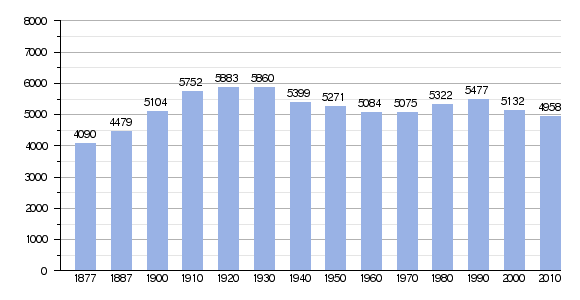
See also
 In Spanish: Finisterre (España) para niños
In Spanish: Finisterre (España) para niños




